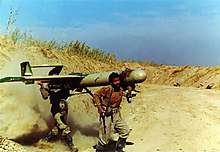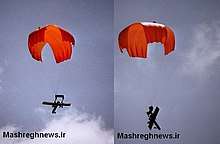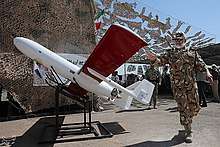Qods Mohajer
| Qods Mohajer | |
|---|---|
 | |
| An Iranian Mohajer-2 in 2014 | |
| Role | light/medium intelligence, surveillance, and reconnaissance (ISR)[1] |
| National origin | Iran |
| Manufacturer | Qods Aviation, Tehran[2] |
| Design group | Qods Aviation |
| First flight | 1985 |
| Introduction | February 1986[3] |
| Status | In service |
| Primary users | Iranian Armed Forces Syria Venezuela Hezbollah |
| Produced | 1980s–present |
| Number built | 253 (mid-2000s)[3] |
The Qods Mohajer (Persian: مهاجر, "Migrant") is an Iranian single-engine tactical unmanned aerial vehicle (UAV) built by the Qods Aviation Industry Company in four main variants from the 1980s to the present day. The Mohajer family is primarily used for reconnaissance, and is among the most mature and well-known Iranian UAVs.[3]
The Mohajer-1 was used during the Iran-Iraq War for battlefield surveillance. The Mohajer-2 was developed in the 1990s with improved avionics and range, and remains in service today. The Mohajer-4 is another evolutionary improvement with again improved range, endurance, and surveillance.[3] The Mohajer-6 is an unmanned combat aerial vehicle, carrying two munitions.
The Mohajer is used by both the Iranian Army and the Islamic Revolutionary Guards Corps (IRGC). It has been exported to Iranian allies in the Middle East and has been used in the Syrian and Iraqi civil wars. In addition, the Mohajer-2 is license-built in Venezuela as the Arpia.
Mohajer-1

The Mohajer was Iran's first drone to enter series production and was used during the Iran–Iraq War. The Mohajer-1 was known simply as "Mohajer" through the 80s and 90s, when it was re-designated "Mohajer-1" as other Mohajer variants had been developed.
Design
The Mohajer-1 had a narrow cylindrical fuselage, twin tailbooms, and straight wings mounted high and to the rear of the body. It had a single engine (unknown model) in a pusher configuration, and was guided by ailerons on the wings, an elevator on the horizontal stablizer, and rudders on the tailbooms. The Mohajer-1 had three fixed landing gear for launch and recovery. It could also be recovered by parachute.[3] The Mohajer-1 was about 8 feet long and had a wingspan of about 10 feet.

The Mohajer-1 carried a single still camera, probably carrying photographic film developed after the drone landed.[3] It was controlled by hobby-class radio, which was easily jammed.[3] In addition, Iran attempted to armed it with six RPG-7 rockets, three under each wing, though this was not very successful.[2][4]
Performance
The Mohajer-1's range is not definitively known, but was severely limited by the hobbyist radio link and lack of an autopilot system, which meant that the aircraft could only surveil Iraqi positions when operated from the Iranian front lines.[3] One source suggests the Mohajer-1 was only able to penetrate 3km into Iraqi lines.[5] On the other hand, another source says the Mohajer-1 had a range of 50 km,[6] and still another source lists a range of 30 km;[7] this may reflect a difference between the aircraft's theoretical range and its real-world performance. There are no details on the Mohajer-1's airspeed, endurance, powerplant, or ceiling.

Operational history
Qods Aviation was formed in 1985[3] and four Mohajer-1s were built that year.[5] The Mohajer-1 was operated by the IRGC's Raad Brigade and was used to correct artillery fire and photograph enemy positions.[3] The Mohajer-1's first known use was in Operation Dawn 8 in 1986.[3] It was also used Karbala 5 in 1987.[5] Mohajer UAVs photographed Iraqi lines until the end of the war and completed 619 sorties by the war's end, taking 53,772 photographs in total.[5] The Mohajer-1 is out of service today.
Though the Mohjajer-1 is out of service today, the Iranians were satisfied with its performance, as it was one of only two Iranian surveillance assets in the war, along with RF-4s.
Mohajer-2
Following the successful use of the Mohajer-1, Iran wanted a version with more range and endurance. This version, which would later be named the Mohajer-2, also had an auto pilot system to fly beyond the line-of-control of its command center. The Mohajer-2 was developed in the 1990s and first seen in 1996,[3] and was designed for surveillance use.[5] as of 2011 than 200 Mohajer-2s had been built.[5]
Design

The Mohajer-2 has a bullet-shaped fuselage, mid-mounted, untapered wings, twin tailbooms, twin rudders, belly skids, and a horizontal tail.[2] The belly skids are non-retractable, but can compress on landing to reduce shock.[5] Apart from the skids, it is an evolution of the Mohajer-1 design.[3] Its airframe is composed substantially of composite materials.[2] The Mohajer-2 is 2.91m long and has a wingspan of 3.8 meters. It is powered by a 25 hp WAE-342 two-cylinder engine.[3]
The Mohajer-2 has an autopilot system, which is able to maintain airspeed, altitude, and stability in flight.[5] The autopilot system can control the aircraft's course via waypoints, or it can be controlled in real time from a ground control station.[3] Like other Iranian drones, the Mohajer-2 lacks over-the-horizon guidance.[3] The Mohajer-2 has a still or video (color or monochrome) camera,[2] either fixed downwards for aerial surveying or mounted on a gimbal for surveillance.[3] In addition, it has a fixed forwards-facing camera for navigation.[3][lower-alpha 1] There is no evidence the Mohajer-2 has been fitted with an infrared camera.[3] It has a onboard digital processor and can downlink sensor imagery.[2] The Mohajer-2 has two stub antenna in the under 10 ghz range, one on each wing, for real-time control.[3] Prototype Mohajer-2s were fitted with two rocket pods for 12 RPG-7 rockets, similar to the Mohajer-1's, but this model did not enter production.[3] The Mohajer-2 has a GPS guidance system.[8]
The Mohajer-2 is launched from a PL3 pneumatic catapult, which can be truck-mounted, wheeled, or ship-mounted.[2] It can also be launched from a JATO platform, though this is uncommon.[3] It is recovered by skid landing or parachute.[3]
Performance
Has an endurance of 1.5 hours and range of 50 km.[2] The Mohajer-2 is about ten feet long and has a wingspan of about 12 feet. The tail wingspan is exactly 3 ft.[2]
Operational history
During the 1990s Afghan civil war, Mohajer drones reportedly monitored the situation.[9] A Mohajer (unknown variant) may have been shot down over Iraq on 19 April 2001.[2] The Mohajer-2 is also known to be operated by Hezbollah. There are also inconclusive reports Mohajer-2s have been used over Syria.[3]
In addition to its military use, the Mohajer-2 can also be used for weather reporting.[5]
It is possible, but unconfirmed, that the Raad-85 is a variant of the Mohajer-2.[3]
Arpia

In 2007, Venezuela signed an agreement with Iran to assemble 12 Mohajer-2 UAVs from knock-down kits supplied by Quds.[3] Venezuelan state-owned defense contractor CAVIM began assembling the drones by 2009.[3] US satellite imagery revealed the facility manufacturing the drones in 2010, and they were unveiled to the public as the CAVIM Arpia in 2012. Venezuela signed a $28 million contract to manufacture the UAVs, though it is unclear why, because this far exceeds the drones' value.[10]
Mohajer-2N
.jpg)
In 2014, Iran introduced the Mohajer-2N, which shares the same design as the Mohajer-2 but has far improved performance. The Mohajer-2N has a range of 150 km and flight endurance of 6 hours. It is believed this is accomplished through fuel tanks in the wings combined with weight savings elsewhere.[3]
Visually, the Mohajer-2N is nearly identical to the Mohajer-2.[3] It is mainly "distinguished" by being 1 cm longer, having a wingspan 2 cm wider, and being five kg heavier.[11] It can be fitted with the Mohajer-2's landing skids or with wheeled landing gear.[3] The Mohajer-2N is recovered by skid landing or parachute.[12]
Mohajer-3
The Mohajer-3, also known as the Dorna, was designed with a new airframe for better performance.[13] It had a square body and featured a low-mounted horizontal stabilizer flush with the main wing, the only member of the Mohajer family configured this way.[13] The Mohajer-3 could be fitted with fixed landing gear, for a runway takeoff, or with skids for a JATO launch.[13] It was recovered by parachute or skid landing.[13] It was powered by an unidentified 25 hp (18.6 kW) piston engine.[2] The Mohajer-3 was announced in 1999.[3]
The Mohajer-3 had a color/monochrome still or video camera,[2] and was able to send images in real time.[13][2] and It had a range of 100 km,[13] an endurance of 2-3 hours, and a cruise speed of 180km/h.[3] It did not have GPS guidance.[2]
It was developed contemporaneously with the Mohajer-4 and did not enter service or production.[3]
Mohajer-4
.jpg)

The Mohajer-4 was designed for both the Iranian Army and the IRGC[13] and entered service in late 1997.[2][13] It may have entered mass production in 1999.[14] It was first documented in 2003.[3] Sources differ slightly on how many have been built; one sources says that 40 have been built as of 2006,[13] while another says that as of the mid-2000s, 34 had been been built.[3]
Design
The Mohajer-4 features a squarish body and low-mounted trapezoidal wings with upward-canted wingtips to lessen drag.[13] It is powered by a two-bladed Limbach L550E four-cylinder, two-stroke 50 hp engine in a pusher configuration.[3][lower-alpha 2] The Mohajer-4 is constructed of composite material.[13] It is 3.64m long and has a wingspan of 5.3m.[13] The Mohajer-4 has a modular design, and components such as the body, wings, and tailbooms can be detached and recombined.[3]
It has three landing skids. The Mohajer-4 can land via landing gear or a parachute.[13]
.jpg)
The Mohajer-4 has a Hyarat 3 guidance and control system, which includes GPS navigation.[2] It normally follows a preprogrammed flight path,[2] but it's mission profile can also be updated in flight via radio uplink.[2] The Mohajer-4 has a fixed forward-facing camera for navigation and either a downward-facing camera for aerial surveying or a gimbal-mounted video camera for surveillance.[3] Sources disagree on whether the Mojajer-4 can carry an infrared camera.[3][2] Like the Mohajer-2, it has a onboard digital processor and can downlink sensor imagery.[2] The Mohajer-4 is also reportedly capable of being fitted for communications relay and has an 'impressive' electronic warfare capability.[2]
Performance
Operational range is increased to 150 km, altitude to 18000 feet and endurance to 7 hours.[2] With a MTOW of 175 kg,[2] the Mohajer-4 is almost double the weight of older versions.[13]
The Mohajer-4 and 4B are operated by a crew of 5-7 men, including two operators.[15] One operator controls the UAV's camera and the ground control station's directional antenna for real time video transfer. The other operator controls the UAV's flight using a software program called FliteMap, which is COTS American software.[15]
Operational history
On November 7, 2004, Hezbollah flew a UAV over northern Israel for about 5 minutes. The UAV entered Israeli airspace at more than 100 knots and an altitude of about 1,000 feet, flew briefly over the seaside city of Nahariya, and fell into the sea. Some sources have identified the UAV as A Mohajer-4.[16] There are reports that Iran sold eight Mohajer-4s to Hezbollah.[17]
Mohajer-4s have been used in the civil wars in Iraq and Syria.[3] On 16 May 2015, the Turkish Air Force shot down a Mohajer-4 that violated its airspace.[18] Mohajer-4s have also crashed, or been shot down, over Islamic State-held territories.[19] A Mohajer-4 in Iraqi markings was downed over Iraq, but it is not clear if the UAV was actually being operated by the Iraqi Armed Forces.[3]

Mohajer-4's are located at Iran's Konorak Air Base[20] and at Bandar Jask.[21] There is a designation of the Mohajer-4 called "Shahin", which may be a sub-variant with unknown differences, or a designation for the Mohajer-4 in Iranian Army Ground service.[3] There is also another sub-variant with unknown differences called the "Hodhod A/100".[5][13]
In addition, Mohajer-4s are used by Iran's border guard to interdict drug smuggling.[2]
Mohajer-4B
Also known as the Sadiq, the Mohajer-4B is a significant evolution of the Mohajer-4 platform with a square fuselage, twin tailbooms, a top-mounted horizontal stabilizer, uncanted wingtips, new landing skids, and straight wings mounted high and to the mid of the body.[3] It was introduced in late 2014.[22] All serial numbers begin "P062A–".
The Mohajer-4B was designed for reconnaissance[23] and has a fixed, forward-facing camera for navigation.[3] With an expanded payload bay, it can carry an IR/EO sensor mounted on a gimbal and a downward-facing surveying camera at the same time, unlike the Mohajer-2 and Mohajer-4, which could only carry one at a time.[3] The Mohajer-4B has a flight ceiling of 15,000 feet, a (max) speed of 200km/h, and an operational radius of 200 km.[23] It weights 242 kg and has an endurance of 6 hours.[23] It may be approximately 7 meters long.[24]
.jpg)
An estimated 36 Mohajer-4Bs have been built as of 2015.[15] Mohajer-4Bs have been used over Syria.[15]
Sadegh-1
Also known as the QOM-1,[25] it is simply a Mohajer-4B with two MANPADS mounted on pylons.[26] It was tested in late 2014[27] and was used to harass a US Navy jet fighter in 2017.[25] Independent assessments of the Sadgh-1 range from "it probably doesn’t work very well" to "fakery."[28]
There is no Mohajer-5.
Mohajer-6
The Mohajer-6 is a persistent ISTAR[29] UAV capable of carrying a multispectral surveillance payload and/or up to two precision-guided munitions.[30] Ten have been manufactured as of February 2018 for the IRGC Ground Forces,[31] and 40 are planned for the IRGC Navy.[31] The Mohajer-6 complements the larger Shahed 129 operated by the IRGC-ASF.[32]
The Mohajer-6 was unveiled in April 2017[33] and entered serial production in February 2018.[34]
Design
The Mohajer-6 has a rectangular fuselage, an upwards-sloping nose, twin tailbooms, a top-mounted horizontal stabilizer, uncanted wingtips, straight wings mounted high and to the rear of the body, and air intakes on the top and bottom of the engine. The Mohajer-6 is controlled by two elevators on the horizontal stabilizer, rudders on the vertical stabilizers, and two ailerons per wing. Unlike other Mohajer variants, it has a three-bladed propeller. The Mohajer-6 has a wingspan of 10 meters and is 5.67 meters long.[30] It is similar in shape to the Selex ES Falco.
The Mohajer-6 has fixed tricycle landing gear, which underwent changes between the unveiling ceremony in 2017 and mass production in 2018, perhaps to accommodate more weight.[35] It is launched and recovered via runway takeoff/landing.[36]
It has a fixed, forward facing camera for navigation and a gimbal on the chin for a laser range finder and multispectral IR and visible light electro-optical imagery.[30] The Mohajer-6 has three antennas, two on its left wing and one on its right, and a pitot tube on its nose. The Mohajer-6 has two hardpoints, one under each wing, which can each carry one Qaem TV/IR-guided missile.[31][lower-alpha 3] It has an autopilot system capable of automatic takeoff and landing.[30] In addition, Iran describes it as capable of being fitted with electronic support measures, communications jamming, or electronic warfare payloads.[30]
Performance
The Mohajer-6 has a max takeoff weight of 600 kgs, a payload of 40 kg, and an operating range of 200 km. It has a max speed of 200 km/h, an endurance of 12 hours, and a ceiling of 18000 feet.[30]
Multiple sources say that although the Mohajer-6 is designed by Qods Aviation, it is manufactured by Qods' longtime rival, Iran Aircraft Manufacturing Industrial Company (HESA).[33][32] Both Qods and HESA are subsidaries of Iran's state-owned Aerospace Industries Organization.[37]
Operational history
Iran's Aerospace Industries Organization describes the Mohajer-6 as "operationally proven",[30] and it has reportedly been used against Jaish ul-Adl.[38] Some Mohajer-6s seem to be based at Qeshm Island.[24]
Operators
This section is not comprehensive!




- PDVSA
- Venezuelan Air Force
- 83rd UAV Squadron
Specifications (Mohajer-2)
Data from Galen Wright[3]
General characteristics
- Crew: none
- Capacity: 15 kg payload
- Length: 2.91 m (9 ft 7 in)
- Wingspan: 3.8 m (12 ft 6 in)
- Empty weight: 70 kg (154 lb)
- Max takeoff weight: 85 kg (187 lb)
- Powerplant: 1 × WAE-342 twin-cylinder piston engine, 19 kW (25 hp)
- Propellers: 2-bladed
Performance
- Maximum speed: 200 km/h (124 mph; 108 kn)
- Range: 50 km (31 mi; 27 nmi)
- Endurance: 1.5h
- Service ceiling: 3,350 m (10,990 ft)
See also
| Wikimedia Commons has media related to Mohajer. |
Aircraft of comparable role, configuration and era
- HESA Ababil[lower-alpha 4]
- SAGEM Crecerelle
- Altec MART/Altec S-MART
- Aerosonde Mk 4.7
In popular culture
- The 1989 Iranian film Mohajer features a fictional unit which operates a Mohajer-1 during the Iran-Iraq War.[40]
References
- 1 2 International Institute for Strategic Studies (IISS) (14 February 2018). "The Military Balance 2018". The Military Balance. Routledge. 118.
- 1 2 3 4 5 6 7 8 9 10 11 12 13 14 15 16 17 18 19 20 21 22 23 24 25 Martin Streetly, ed. (2014). Jane's All the World's Aircraft: Unmanned 2014-2015. London: IHS Jane's. p. 81-82. ISBN 978-0710630964.
- 1 2 3 4 5 6 7 8 9 10 11 12 13 14 15 16 17 18 19 20 21 22 23 24 25 26 27 28 29 30 31 32 33 34 35 36 37 38 39 40 41 42 43 44 45 46 47 48 49 50 51 52 53 Wright, Galen (5 March 2015). "The Arkenstone - ارکنستون: Mohajer UAV".
- ↑ "کرار؛مهاجم خستگی ناپذیر در برد1000 کیلومتری". mashreghnews.ir. 28 September 2011.
- 1 2 3 4 5 6 7 8 9 10 "نگاهی به نقش ناشناخته "تلاش" و "مهاجر" در کربلای 5 و والفجر 8". mashreghnews.ir. 1 October 2011.
- ↑ "A Report on Iran's Drone Units: Army's Online Eyes Monitoring Border Moves". en.farsnews.com. Tehran. 26 August 2013.
- ↑ Wright, Galen (5 February 2011). "The Arkenstone - ارکنستون: Mohajer UAV".
- ↑ "Mohajer 2 - Uav Surveillance System". MINDEX – Ministry of Defence Export Center.
- ↑ Pike, John. "Mohajer". www.globalsecurity.org.
- ↑ Committee on Foreign Affairs (18 March 2015). "Iran and Hezbollah in the Western Hemisphere". Government Publishing Office – via Internet Archive.
- 1 2 3 Rawnsley, Adam. "The Artesh Ground Forces Vali-e-Asr Drone Group (Updated)". rawnsl notebook.
- ↑ "Iran Showcases New Version of Mohajer-Class Drone". Tehran: Tasnim News Agency. 22 November 2014.
- 1 2 3 4 5 6 7 8 9 10 11 12 13 14 15 "مهاجر3 و 4 مجوز ورود ایران به لیگ برتر هواپیماهای بدون سرنشین + عکس". mashreghnews.ir. 9 October 2011.
- ↑ "Iran says military to mass produce drones". Reuters. Tehran. 19 July 1999.
- 1 2 3 4 5 Wright, Galen (22 September 2015). "UAV Update - A Look Inside the Mohajer-4's GCS". The Arkenstone - ارکنستون.
- ↑ Eugene Miasnikov (6 December 2004). "Terrorists Develop Unmanned Aerial Vehicles". Center for Arms Control, Energy and Environmental Studies at MIPT.
- ↑ Gary Ackerman; Jeremy Tamsett, Jihadists and Weapons of Mass Destruction. CRC Press. ISBN 9781420069648. p. 122.
- ↑ Rufiz Hafizoglu (18 May 2015). "Turkish Air Force shoots down not helicopter but Syrian drone - defense ministry". Baku, Azerbaijan: Trend News Agency.
- ↑ Rawnsley, Adam (24 January 2015). "Iran's Drones Are Back in Iraq".
- ↑ Chris Biggers (30 April 2015). "Satellite Imagery Confirms Iran Deploying Additional UAVs along the Coast". bellingcat.
- ↑ Rawnsley, Adam; Biggers, Chris (2 April 2015). "We Found Iran's Secretive Drone Base" – via www.thedailybeast.com.
- ↑ "Galen Wright on Twitter".
- 1 2 3 "Galen Wright on Twitter". Twitter. 7 October 2015.
- 1 2 "Iran Relocates Radar and Expands UAV Airfield on Qeshm". bellingcat. 13 March 2018.
- 1 2 Andrew deGrandpre (8 August 2017). "Iranian drone that harassed Navy fighter jet is capable of carrying missiles, but was unarmed, official says". Washington Post.
- ↑ "Adam Rawnsley on Twitter". Twitter. 9 Aug 2017.
- ↑ "جهان نيوز - انهدام پهپاد مهاجم فرضی توسط نخستین پهپاد جدید ایران +فیلم". jahannews.com. 23 September 2014.
- 1 2 Rawnsley, Adam (24 September 2014). "Iran Has a Dogfighting Drone".
- ↑ Keshavarz and Bunker (March 2018). "Iran Develops UAS with 'Smart Bomb' Capability". Operational Environment Watch: Foreign News & Perspectives of the Operational Environment. Foreign Military Studies Office. 8 (3): 18.
- 1 2 3 4 5 6 7 "Islamic Republic of Iran Ministry of Defence and Aerospace Industries Organization, quoted by Yuri Lyamin on Twitter". Twitter. 21 July 2017.
- 1 2 3 "Babak Taghvaee on Twitter". Twitter. Feb 5, 2018.
- 1 2 3 4 Babak Taghvaee (8 February 2018). "Photos: New Iranian Mohajer-6 unmanned combat aerial vehicles". defence-blog.com.
- 1 2 "Iran Unveils Its Newest Unmanned Combat Aerial Vehicle 'Mohajer-6'". Southfront.org. 16 April 2017.
- 1 2 Binnie, Jeremy (February 7, 2018). "Iran's Mohajer 6 armed UAV goes into production". Jane's Information Group.
- ↑ "Hossein Dalirian on Twitter". Twitter. Feb 5, 2018.
- ↑ "افتتاح خط تولید انبوه پهپاد مهاجر۶ مسلح به بمبهای هوشمند قائم". kayhan.ir.
- ↑ Galen Wright (February 5, 2011). "Ababil UAV". thearkenstone.blogspot.com.
- ↑ "Babak Taghvaee on Twitter". Twitter. 29 June 2018.
- ↑ "LIBYA : Haftar's strange Iranian drone". Africa Intelligence. 5 October 2017.
- ↑ "The Immigrant" – via www.imdb.com.
- ↑ early Mohajer-2s lack this camera.
- ↑ some prototypes were equipped with different engines.[3]
- ↑ For unknown reasons most of the Mohajer-6s displayed at Iran's mass production announcement in 2018 had no hardpoints[34]
- ↑ The Ababil-2 compares with the Mohajer-2; the Ababil-3 compares with the Mohajer-4.[3]